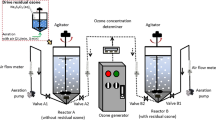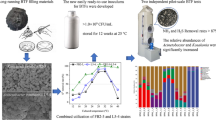Abstract
The operation and performance of a biotrickling filter for methanol (MeOH) and hydrogen sulfide (H2S) removal at acid pH was studied. Excess biomass in the filter bed, causing performance loss and high pressure drop, was controlled by intermittent addition, of ozone (O3) and hydrogen peroxide (H2O2). The results showed that after adaptation to acid pH, the maximum elimination capacity (EC) reached for MeOH was 565 g m−3 h −1 (97 % RE). High MeOH loads resulted in increased biomass concentration within the support, triggering reductions in the removal efficiency (RE) for both compounds close to 50 %, and high pressure drop. At this stage, an inlet load of 150.2 ± 16.7 g m−3 h−1 of O3 was fed by 38 days favoring biomass detachment, and EC recovery and lower pressure dropped with a maximum elimination capacity of 587 g m−3 h−1 (81 % RE) and 15.8 g m−3 h−1 (97 % RE) for MeOH and H2S, respectively. After O3 addition, a rapid increase in biomass content and higher fluctuations in pressure drop were observed reducing the system performance. A second treatment with oxidants was implemented feeding a O3 load of 4.8 ± 0.1 g m−3 h−1 for 7 days, followed by H2O2 addition for 23 days, registering 607.5 gbiomass L−1 packing before and 367.5 gbiomass L−1 packing after the oxidant addition. PCR-DGGE analysis of different operating stages showed a clear change in the bacterial populations when O3 was present while the fungal population was less affected.





Similar content being viewed by others
References
Adams CD, Gorg S (2002) Effect of pH and gas-phase ozone concentration on the decolorization of common textile dyes. J Environ Eng 128:293–298. doi:10.1061/(ASCE)0733-9372~2002!128:3(293)
Alcántara S, Velasco A, Revah S (2004) Sulfur formation by steady-state continuous cultures of a sulfoxidizing consortium and Thiobacillus thioparus ATCC 23645. Environm Technol 25:1151–1157. doi:10.1080/09593330.2004.9619409
APHA, Standards Methods for the Examination of Water of Wastewater (1998) 20th ed. American Public Health Association-American Water Works. Association-Water Pollution Control Federation (AWWA-WPCF), Washington, DC
Arellano-García L, González-Sánchez A, Baquerizo G, Hernández-Jimenez S, Revah S (2010) Treatment of carbon disulfide and ethanethiol vapors in alkaline biotrickling filters using an alkaliphilic sulfo-oxidizing bacterial consortium. J Chem Technol Biotechnol 85:328–335. doi:10.1002/jctb.2328
Arellano-García L, Dorado AD, Morales-Guadarrama A, Sacristan E, Gamisans X, Revah S (2015) Modelling the effects of biomass accumulation on the performance of a biotrickling filter packed with PUF support for the alkaline biotreatment of dimethyl disulfide vapors in air. Appl Microbiol Biotechnol 99:97–107. doi:10.1007/s00253-014-5929-7
Auria R, Frere G, Morales M, Acuña ME, Revah S (2000) Influence of mixing and water addition on the removal rate of toluene vapors in a biofilter. Biotechnol Bioeng 68:448–455. doi:10.1002/(SICI)1097-0290(20000520)68:4<448::AID-BIT10>3.0.CO;2-2
Barcón T, Alonso-Gutierrez J, Omil F (2012) Molecular and physiological approaches to understand the ecology of methanol degradation during the biofiltration of air streams. Chemosphere 87:1179–1185. doi:10.1016/j.chemosphere.2011.12.039
Bertoldi S, Farè S, Haugen HJ, Tanzi MC (2015) Exploiting novel sterilization techniques for porous polyurethane scaffolds. J Mater Sci Mater Med 26:182. doi:10.1007/s10856-015-5509-0
Cercado B, Auria R, Cardenas B, Revah S (2012) Characterization of artificially dried biofilms for air biofiltration studies. J Environ Sci Health A Tox Hazard Subst Environ Eng 47:940–948. doi:10.1080/10934529.2012.667292
Christensen BE, Naper T, Vollan K, Smidsrod O, Bake R (1990) Biofilm removal by low concentration of hydrogen peroxide. Biofouling 2:165–175. doi:10.1080/08927019009378142
Chung YC (2007) Evaluation of gas removal and bacterial community diversity in a biofilter developed to treat composting exhaust gases. J Hazard Mater 144:377–385. doi:10.1016/j.jhazmat.2006.10.045
Ding Y, Das KC, Whitman WB, Kastner JR (2006) Enhanced biofiltration of hydrogen sulfide in the presence of methanol and resultant bacterial diversity. Trans ASABE 49:2051–2059. doi:10.13031/2013.22266
Dong T, Zhang Y, Islam MDS, Liu Y, El-Din MG (2015) The impact of various ozone pretreatment doses on the performance of endogenous microbial communities for the remediation of oil sands process-affected water. Int Biodeter Biodegr 100:17–28. doi:10.1016/j.ibiod.2015.01.014
Dubois M, Gilles KA, Hamilton JK, Rebers PA, Smith F (1956) Colorimetric method for determination of sugars and related substances. Anal Chem 28:350–356. doi:10.1021/ac60111a017
Egli T, Fiechter A (1981) Theoretical analysis of media used in the growth of yeasts on methanol. J Gen Microbiol 123:365–369. doi:10.1099/00221287-123-2-365
Flores-Valle SO, Ríos-Bernÿ O, Chanona-Pérez J, Fregoso-Aguilar T, Morales-González JA, Prado-Rubianes OJ, Herrera-Bucio R, López-Albarán P, Morales-González A, Garibay-Febles V, Domínguez EG, Kennes C, Veiga-Barbazán MC, Mendoza-Pérez JA (2011) A comparative study of physical and chemical processes for removal of biomass in biofilters. Molecules 16:6927–6949. doi:10.3390/molecules16086927
García-Pérez T, Aizpuru A, Arriaga S (2013) By-passing acidification limitations during the biofiltration of high formaldehyde loads via the application of ozone pulses. J Hazard Mater 262:732–740. doi:10.1016/j.jhazmat.2013.09.053
González-Sánchez A, Revah S, Deshusses MA (2008) Alkaline biofiltration of H2S odors. Environ Sci Technol 42:7398–7404. doi:10.1021/es800437f
Gosselin F, Madeira LM, Juhna T, Block JC (2013) Drinking water and biofilm disinfection by Fenton-like reaction. Water Res 47:5631–5638. doi:10.1016/j.watres.2013.06.036
Hu QY, Wang C, Huang KX (2015) Biofiltration performance and characteristics of high-temperature gaseous benzene, hexane and toluene. Chem Eng J 27:689–695. doi:10.1016/j.cej.2015.05.019
Jin Y, Veiga MC, Kennes C (2007) Co-treatment of hydrogen sulfide and methanol in a single-stage biotrickling filter under acidic conditions. Chemosphere 68:1186–1193. doi:10.1016/j.chemosphere.2007.01.069
Kong X, Wang C, Ji M (2013) Analysis of microbial metabolic characteristics in mesophilic and thermophilic biofilters using Biolog plate technique. Chem Eng J 230:415–421. doi:10.1016/j.cej.2013.06.073
Lauderdale C, Chadik P, Kirisits MJ, Brown AJ (2012) Engineered biofiltration: enhanced biofilter performance through nutrient and peroxide addition. J Am Water Works ASS 104:E298–E309. doi:10.5942/jawwa.2012.104.0073
López ME, Rene ER, Malhautier L, Rocher J, Bayle S, Veiga MC, Kennes C (2013) One-stage biotrickling filter for the removal of a mixture of volatile pollutants from air: performance and microbial community analysis. Bioresour Technol 138:245–252. doi:10.1016/j.biortech.2013.03.136
Mara D, Horan NJ (2003) Handbook of water and wastewater microbiology. Academic press, 832. ISBN9780124701007
Meng L, Xi J, Yeung M (2016) Degradation of extracellular polymeric substances (EPS) extracted from activated sludge by low-concentration ozonation. Chemosphere 147:248–255. doi:10.1016/j.chemosphere.2015.12.060
Miller AR (1986) Oxidation of cell wall polysaccharides by hydrogen peroxide: a potential mechanism for cell wall breakdown in plants. Biochem Biophys Res Commun 141:238–244. doi:10.1016/S0006-291X(86)80359-X
Moussavi G, Mohseni M (2007) Using UV pretreatment to enhance biofiltration of mixtures of aromatic VOCs. J Hazard Mater 144:59–66. doi:10.1016/j.jhazmat.2006.09.086
Mudliar S, Giri B, Padoley K, Satpute D, Dixit R, Bhatt P, Pandey R, Juwarkar A, Vaidya A (2010) Bioreactors for treatment of VOCs and odours—a review. J Environ Manag 91:1039–1054. doi:10.1016/j.jenvman.2010.01.006
Prenafeta-Boldú FX, Guivernau M, Gallastegui G, Viñas M, Sybren de Hoog G, Elías A (2012) Fungal/bacterial interactions during the biodegradation of TEX hydrocarbons (toluene, ethylbenzene and p-xylene) in gas biofilters operated under xerophilic conditions. FEMS Microbiol Ecol 80:722–734. doi:10.1111/j.1574-6941.2012.01344.x
Rakness K, Gordon G, Langlais B, Masschelein W, Matsumoto N, Richard Y, Michael RC, Somiya I (1996) Guideline for measurement of ozone concentration in the process gas from an ozone generator. Ozone Sci Eng 18:209–229. doi:10.1080/01919519608547327
Ravin NV, Eldarov MA, Kadnikov VV, Beletsky AV, Schneider J, Mardanova ES, Elena M, Smekalova EM, Zvereva MI, Dontsova OA, Mardanov AV, Skryabin KG (2013) Genome sequence and analysis of methylotrophic yeast Hansenula polymorpha DL1. BMC Genomics 14:837. doi:10.1186/1471-2164-14-837
Rene ER, López ME, Veiga MC, Kennes C (2010) Steady- and transient-state operation of a two-stage bioreactor for the treatment of a gaseous mixture of hydrogen sulphide, methanol and α-pinene. J Chem Technol Biotechnol 85:336–348. doi:10.1002/jctb.2343
Revah S, Morgan-Sagastume JM (2005) Methods of odor and VOC control. In: Biotechnology for odor and air pollution control. Springer Berlin Heidelberg, pp 29–63
Roncero MB, Queral MA, Colom JF, Vidal T (2003) Why acid pH increases the selectivity of the ozone bleaching processes. Ozone-Sci Eng 25:523–534. doi:10.1080/01919510390481838
Sempere F, Gabaldón C, Martínez-Soria V, Marzal P, Penya-roja JM, Álvarez-Hornos FJ (2008) Performance evaluation of a biotrickling filter treating a mixture of oxygenated VOCs during intermittent loading. Chemosphere 73:1533–1539. doi:10.1016/j.chemosphere.2008.08.037
Sologar VS, Lu Z, Allen DG (2003) Biofiltration of concentrated mixtures of hydrogen sulfide and methanol. Environ Prog 22:129–136. doi:10.1002/ep.670220215
Tachikawa M, Yamanaka K (2014) Synergistic disinfection and removal of biofilms by a sequential two-step treatment with ozone followed by hydrogen peroxide. Water Res 64:94–101. doi:10.1016/j.watres.2014.06.047
Wang C, Xi JY, Hu HY, Yao Y (2009) Stimulative effects of ozone on biofilter treating gaseous Chlorobenzene. Environ Sci Technol 43:9407–9412. doi:10.1021/es9019035
Wang L, Yang C, Cheng Y, Huang J, Yang H, Zeng G, Lu L, He S (2014) Enhanced removal of ethylbenzene from gas streams in biotrickling filters by Tween-20 and Zn (II). J Environ Sci 26:2500–2507. doi:10.1016/j.jes.2014.04.011
Wei ZS, Li HQ, He JC, Ye HQ, Huang QR, Luo YW (2013) Removal of dimethyl sulfide by the combination of non-thermal plasma and biological process. Bioresour Technol 146:451–456. doi:10.1080/10934529709376619
Xi J, Saingam P, Gu F, Hu YH, Zhao X (2014) Effect of continuous ozone injection on performance and biomass accumulation of biofilters treating gaseous toluene. Appl Microbiol Biotechnol 98:9437–9446. doi:10.1007/s00253-014-5888-z
Yang C, Chen H, Zeng G, Yu G, Lou S (2010) Biomass accumulation and control strategies in gas biofiltration. Biotechnol Adv 28:531–540. doi:10.1016/j.biotechadv.2010.04.002
Zehraoui A, Hassan AA, Sorial GA (2013) Biological treatment of n-hexane and methanol in trickle bed air biofilters under acidic conditions. Biochem Eng J 77:129–135. doi:10.1016/j.bej.2013.06.001
Zhang Y, Peng A, Yang Y, Liu J, Qiu G (2013) Isolation, characterization of Acidiphilium sp. DX1-1 and ore bioleaching by this acidophilic mixotrophic organism. Trans Nonferrous Met Soc China 23:1774–1782. doi:10.1016/S1003-6326(13)62660-6
Acknowledgments
The authors thank Universidad Autónoma Metropolitana and CONACYT for the scholarship (372404), as well as the CI3M Center by conducting analyses of MRI. Special thanks to Dra. Angélica López Moreno for their help and collaboration in the analysis of molecular biology, as well as to Dra. Alejandra Serrato Díaz and to the Laboratory of Molecular Biology of the UAM-Iztapalapa.
Author information
Authors and Affiliations
Corresponding author
Ethics declarations
This article does not contain any studies with human participants or animals performed by any of the authors.
Conflict of interest
The authors declare that they have no conflict of interest.
Electronic supplementary material
ESM 1
(PDF 449 kb)
Rights and permissions
About this article
Cite this article
García-Pérez, T., Le Borgne, S. & Revah, S. Ozone and hydrogen peroxide as strategies to control biomass in a trickling filter to treat methanol and hydrogen sulfide under acidic conditions. Appl Microbiol Biotechnol 100, 10637–10647 (2016). https://doi.org/10.1007/s00253-016-7861-5
Received:
Revised:
Accepted:
Published:
Issue Date:
DOI: https://doi.org/10.1007/s00253-016-7861-5




